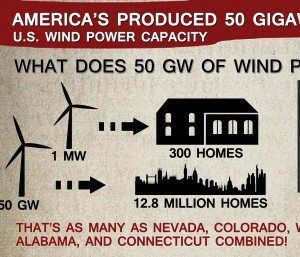Wind energy in the United States hit a new benchmark, reaching 50 gigawatts (GW) of electric capacity in the second quarter of 2012.
The announcement was made by Denise Bode, CEO of the American Wind Energy Association (AWEA) at the National Clean Energy Summit in Los Vegas, Nevada.
So far this year, according to the AWEA, 2,800 megawatts (MW) of wind, along with 1,400 wind turbines have been installed across the US, helping the wind industry reach this fantastic achievement. Many of the new installations have come from new projects in Nevada, Idaho, Iowa, Hawaii Oklahoma, and California. Some of the key projects that are going in across six of these states, according to the AWEA include:
- Pattern Energy’s Spring Valley wind farm, 30 miles east of Ely, Nevada (151.8 MW)
- Enel Green Power North America’s Rocky Ridge wind farm in Oklahoma (148.8 MW)
- enXco’s Pacific Wind project in Kern County, California (140 MW)
- Utah Associated Municipal Power’s Horse Butte project in Idaho (57.6 MW)
- First Wind’s Kaheawa Wind II wind farm in Hawaii (21 MW)
What has occurred in the wind industry with the US reaching that plateau is quite remarkable. Consider the following:
- Between 1981 and 2003, 5 GW of wind power was generated. That number doubled to 10 GW by 2006, then 25 GW by 2008, and now 50 GW in 2012.
- Nuclear energy was the last new energy technology to reach 50 GW, done in the late 1970’s and 1980’s.
The next question you are going to wonder is how much 50 GW of wind energy gets you. This beautiful infographic below, supplied by the AWEA, shows just how much impact 50 GW of wind power can do:
The most interesting fact I found out from this infographic was that wind potential is enough to take out coal power plants in the US. 50 GW of wind provides the same amount of energy as 44 coal fire power plants, or 11 nuclear power plants. The future potential to move at a lighting-fast pace and replace these sunset energy sources is very realistic, especially when you consider that 39 states now have utility-sized wind farms, according to the AWEA.
Politicians were pleased with the US wind energy’s latest milestone. “This milestone for wind-energy production marks continued success for this clean, renewable and domestically produced energy source,” said Republican Senator Chuck Grassley in a statement. “Wind energy has exceeded expectations since I first authored the tax incentive, in 1992, and offers an ideal for expanded production and use of alternative energy sources in the future.”
“It is amazing that 50,000 megawatts of our nation’s power is generated from clean and affordable wind energy,” Oklahoma Republican Frank Lucas Said.
“This is a very big milestone for the wind industry, and I am proud the Rocky Ridge Wind Project has contributed to this great success. As a leader of Congress, representing Oklahoma’s Third Congressional District, I have supported the wind energy in the past, and I will continue to support it in the future,” he said.
The impact of the wind industry isn’t just on the environment but also economically, on the domestic level. Most of the capacity growth has come from turbines made in the USA, around 60%, according to the statement.
Mike Garland, CEO of Pattern Energy in the statement also agreed with the positive economic impact the wind industry has had.
“We’re very proud that Spring Valley Wind is not only Nevada’s first wind power facility but also helps America reach 50 gigawatts of clean wind generation.”
“Spring Valley Wind brought over 250 jobs to Nevada and will now power up to 45,000 local homes with zero emissions. This project will also generate significant tax revenue and community benefits for decades to come, demonstrating that wind energy is a meaningful long-term investment in the economic health of local communities.”
However, uncertainty about the Production Tax Credit (PTC), credited for spurring the development of the domestic wind industry, has plagued wind developers and threatens jobs, according to Denise Bode:
“These truly are the best of times and could be the worst of times for American wind power,”
“This month we shattered the 50-gigawatt mark, and we’re on pace for one of our best years ever in terms of megawatts installed. But because of the uncertainty surrounding the extension of the Production Tax Credit, incoming orders are grinding to a halt,”
“Layoffs have begun up and down our American manufacturing supply chain, which the industry has so proudly has built up in support of the U.S. economy and made-in-the USA manufacturing. And when incoming orders stop, so do factories. Congress must act now to give wind energy a stable business environment to keep producing all this homegrown power, and save 37,000 American jobs by the first quarter of next year.”
However, hope is on the horizon, as the Senate Finance Committee on August 7th passed the “Family and Business Tax Cut Act.” The act would help extend the PTC, vital for further industrial growth.
Overall, 50GW of wind electricity capacity is something to be celebrated by everyone.
![]() Clean Technica (http://s.tt/1kvq3) – Reproduced with permission.
Clean Technica (http://s.tt/1kvq3) – Reproduced with permission.











